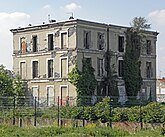François Coignet
François Coignet | |
|---|---|
 | |
| Born | 10 February 1814 Lyon, France |
| Died | 30 October 1888 (aged 74) Saint Denis, Paris, France |
| Nationality | French |
| Occupation | Entrepreneur |
| Spouse(s) | Clarisse Coignet |
François Coignet (10 February 1814 – 30 October 1888) was a French industrialist and a pioneer in the development of reinforced concrete as the first person to use iron-reinforced concrete to construct buildings.[1][2]
Biography[]
Coignet, along with his brothers Louis (b. 1819) and Stephane (b. 1820), took over the family business, a chemical plant in Lyon, in 1846.[1] In 1847, he built some concrete houses using poured cement that was not reinforced with iron.[1]
In 1850, Coignet married Clarisse Gauthier(1823-1918)[3] and a year later, he settled in Saint-Denis, a commune near Paris, where in 1852 he opened a second plant and obtained a patent for cement clinker. Coignet then built a cement factory at Saint-Denis using exposed lime walls and followed the pisé de terre system, a rammed-earth method of construction. This was the first time he worked with this method in concrete. Later, he took out a patent in England entitled "Emploi de Béton", which gave details of his construction techniques.[4]
Coignet started experimenting with iron-reinforced concrete in 1852 and was the first builder to use it as a building material.[5] He decided, as a publicity stunt and to promote his cement business, to build a house made of béton armé, a type of reinforced concrete.[1] In 1853, he built the world's first iron-reinforced concrete structure, a four-story house at 72 rue Charles Michels[2] in St. Denis. The house was designed by local architect .[6]

1855 architectural drawing

Facing east and north

Facing south and east
72 rue Charles-Michels in 2010
In 1855, a committee of fourteen architects led by Henri Labrouste inspected the house. In Labrouste’s report, he said all of the work for the house was done entirely of cement and artificial stone. It also showed Coignet used different materials of little value and mixed them with lime and water to make decorative moldings and cornice that crowned the building. The railing was also a molded concrete mass. In March of that year, he had taken out a patent entitled Béton Économique that showed how inexpensive aggregates could be used in concrete. He then built several more concrete houses that were still standing in 2021.[6]
This report showed Coignet made a concrete mixture of wood ash and slag with lime and then used this mixture in the rammed earth method of construction. The report said the committee had doubts about the soundness of Coignet's techniques and that they could be dangerous. As of 2021, the house has been abandoned for many years and squatters have periodically taken over the property. While it has deteriorated, the house is classed as a world patrimony and has been classified as a historical monument since 1998.[7]
Coignet had an exhibit at the 1855 Paris Exposition to show his technique of reinforced concrete. At the exhibit, he forecast the technique would replace stone as a means of construction. In 1856, he patented a technique of reinforced concrete using iron tirants. In 1861 he published his techniques.[1]
Coignet is the inventor of molded concrete, which is known as Béton Coignet. He had much success building with this technique. He became a renowned building contractor and showed his many designs, including the molded concrete church of Le Vésinet near Paris, which, with its 130-foot (40 m) spire, is the first modern monumental concrete building.[8]
Construction projects[]

One of Coignet's largest projects was the 87 miles (140 km) of the (Paris metropolitan water supply) with over four miles (6.4 km) of arches of over 100-foot (30 m)-high spans. He built the aqueduct between 1867 and 1874. Coignet also helped construct the lighthouse at Port Said, Egypt, the high retaining walls of the Passy Cemetery and Trocadéro Cemetery in Paris.[9]
Gallery[]

Lighthouse of Port Said
Port Said, Egypt
Passy Cemetery walls
Paris, France
Trocadéro and cemetery
Paris, France
Far view of sea wall at
Saint-Jean-de-Luz, France
Close-up of sea wall at
Saint-Jean-de-Luz, France
See also[]
Notes[]
- ^ a b c d e Day, p. 284
- ^ a b Britannica staff writer (2020). "François Coignet / French house builder". Britannica. Archived from the original on April 2, 2015. Retrieved July 10, 2021.
- ^ staff writer (2021). "Claude François Coignet". Geneanet. Retrieved July 10, 2021.
- ^ Sutherland, p. 13
- ^ Encyclopædia Britannica (1993), p. 323 The first use of iron-reinforced concrete was by the French builder François Coignet in Paris in the 1850s.
- ^ a b Collins, p. 28
- ^ staff writer (2021). "La première maison en béton de France: la maison François Cognet à Saint-Denis". Nos partenaires institutionnels OT Plaine Commune Grand Paris/Conseil départemental/VisitParisRegion/OTCP. Archived from the original on July 17, 2011. Retrieved July 10, 2021.
- ^ Collins, p. 33
- ^ Concrete and constructional engineering, p. 159
References[]
- Collins, Peter et al., Concrete: the vision of a new architecture, McGill-Queen's Press - MQUP, 2004, ISBN 0-7735-2564-5
- Day, Lance, Biographical Dictionary of the History of Technology, Routledge, 2003, ISBN 0-203-02829-5
- Encyclopædia Britannica, 1993, The New Encyclopædia Britannica: micropaedia: ready reference, Edition: 15, illustrated, ISBN 0-85229-571-5
- Sutherland, R. J. M. et al., Historic Concrete: Background to Appraisal, Thomas Telford, 2001, ISBN 0-7277-2875-X
- 1814 births
- 1888 deaths
- Concrete pioneers
- Engineers from Lyon
- French civil engineers
- Structural engineers









